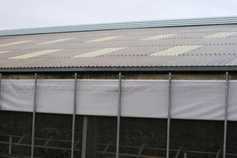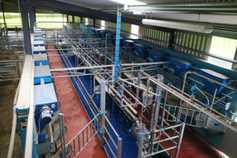Click on the images below to download full-size plans.
Description: 12-bay cubicle house with 160 cubicle places. There are two double rows of cubicles and ample area per cow and feed space.![]()
There is an A-shaped roof, with feeding area along the sides of the shed. Tanks are arranged to minimise scraper runs, to receive an even amount of slurry each and to provide slats at the crossover points. The feed passage at the windy side is closed off to the elements to provide shelter and prevent rain entry and a low-level breeze across the shed.
Feed space: 57.2m of feed space at each side for 160 cows allows over 0.7m of feed space per cow. 0.66m to 0.7m per cow is necessary if all cows are to line up at once – space suitable for buffer feeding.Water troughs: There are six water troughs, which is one for every 27 cows.Area per cow: There is 7.59m2 (81ft2) per cow of animal area within the shed (between the feed barriers). Along the feed barrier there is 3.1m2 area per cow (no congestion or bullying). Crossovers are almost the width of three cows. The central cubicle passage is 3m. Passages along the feed barrier are 4.3m wide, which should be adequate provided cows are allowed in and out all three gable end doors for buffer feeding. As regards grouping of cows – three groups would be easy to organise and manage in the shed.![]() Total number of cows: 160 or one cubicle space per cow.Cubicle size: Cubicles are head to head and are 2.4m long. The width of the cubicle as drawn in is 1.17m but going to 1.18 would take very little off crossover width. Cubicle slope is about one in 20. The long cubicles allow good lunging space for getting up and lying down and allow cows more access to breathe in fresher air. A brisket board is needed to position cows correctly when lying down otherwise excessive soiling of cubicle beds will occur or possible injuries from cows shuffling up too far.Capacity of tanks: There is a single tank (3.8m slat) crossing each end of the shed and a double tank (2 x 3.8m slats) across the middle. Total capacity is 1,081m3 and net storage is 974m3. This will cater for 160 cows for almost 18 weeks. Tank length complies with S123 for agitation being less than 32m for the single tanks with agitation points at both ends.Slurry collection: The scrapers would work very efficiently with no idle runs. The way the tanks are spaced out ensures the tide of slurry in front of them is kept to a minimum – good for hygiene, clean cows and less foot problems. Slurry is evenly divided between tanks. Ventilation: The inlet is via vented sheeting and a continuous opening under the eave at the back. As the shed is wider than 24m, the continuous opening with the vented sheeting is shown with a continuous opening of at least 450mm above the vented sheeting. Plastic fabric mesh or spaced boarding are recommended also. The open side of the shed should be sheltered. The outlet is a standard ridge cap for this width of shed according to S101.Costs: The cost as calculated is high. This design with two rows of cubicles parallel to the feed passage is regarded as the best (it could be as in drawings or have a central passage or be single-sided. The three-row cubicle design is good also but has the limitation of having only 0.45 to 0.5m feed space per cow unless you are prepared to feed along one gable end as well).
Total number of cows: 160 or one cubicle space per cow.Cubicle size: Cubicles are head to head and are 2.4m long. The width of the cubicle as drawn in is 1.17m but going to 1.18 would take very little off crossover width. Cubicle slope is about one in 20. The long cubicles allow good lunging space for getting up and lying down and allow cows more access to breathe in fresher air. A brisket board is needed to position cows correctly when lying down otherwise excessive soiling of cubicle beds will occur or possible injuries from cows shuffling up too far.Capacity of tanks: There is a single tank (3.8m slat) crossing each end of the shed and a double tank (2 x 3.8m slats) across the middle. Total capacity is 1,081m3 and net storage is 974m3. This will cater for 160 cows for almost 18 weeks. Tank length complies with S123 for agitation being less than 32m for the single tanks with agitation points at both ends.Slurry collection: The scrapers would work very efficiently with no idle runs. The way the tanks are spaced out ensures the tide of slurry in front of them is kept to a minimum – good for hygiene, clean cows and less foot problems. Slurry is evenly divided between tanks. Ventilation: The inlet is via vented sheeting and a continuous opening under the eave at the back. As the shed is wider than 24m, the continuous opening with the vented sheeting is shown with a continuous opening of at least 450mm above the vented sheeting. Plastic fabric mesh or spaced boarding are recommended also. The open side of the shed should be sheltered. The outlet is a standard ridge cap for this width of shed according to S101.Costs: The cost as calculated is high. This design with two rows of cubicles parallel to the feed passage is regarded as the best (it could be as in drawings or have a central passage or be single-sided. The three-row cubicle design is good also but has the limitation of having only 0.45 to 0.5m feed space per cow unless you are prepared to feed along one gable end as well). There is more area and feed space per cow which adds to the cost. Going for big cubicles, wide crossovers, and wide passages adds expense but is necessary – we should avoid using the dimensions used in the 1970s for today’s cubicle houses. The slurry storage is little greater than the minimum of 16 weeks (more capacity would be needed for 20 and 22 weeks storage or to have surplus).
Closing in one side from the elements adds to the costs but with outside feeding is probably necessary unless the site is very sheltered.
DAFM specifications: Refer to S100, S101, S102, S123 and S129. Read more
Special focus: planning for TAMS II and FBIS grants





SHARING OPTIONS: